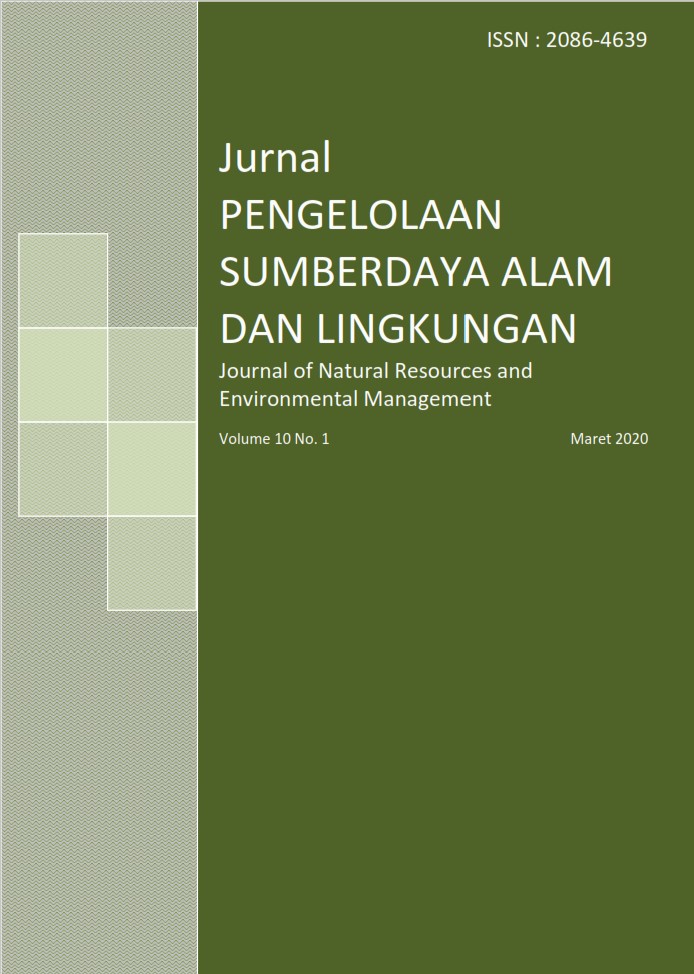Environment Biophysical of Mangrove Forest in Langsa City, Aceh
Abstract
Mangrove ecosystem is an area that serves as a interface between the land and sea, but at the moment has a lot of damage. The phenomenon of damage to the mangrove forest ecosystem also occurred in Langsa City. This study aims to analyse biophysical conditions of mangrove forest ecosystems in Langsa City. The method used in this study is to combine qualitative and quantitative descriptive approaches. Results of the study show that the area of mangrove forest in the study has increased as large as 324.29 ha in the period of 6 years (2007-2013). The mangrove flora in Langsa City consist of a group of true mangrove flora and mangrove associates, consisting of 14 families and 25 species. The criticality of mangrove forests in the research location is classified as damaged (1,955.96 ha) and severely damaged (2,556.82 ha).
References
Biber, P.D., 2006. Measuring the effects of salinity stress in the red mangrove Rhizophora mangle L. African Journal Agriculture Research 1(1), pp. 1-4.
Carter, H.N., S.W. Schmidt., A.C. Hirons., 2015. An international assessment of mangrove management: Incorporation in integrated coastal zone management. Journal Diversity (7), pp. 74-104.
Cox, G.W., 1985. Laboratory Manual of General Ecology. 5 th ed. Dubuque: WCM Brown.
[Dephut] Departemen Kehutanan., 2005. Pedoman Inventarisasi dan Identifikasi Lahan Kritis Mangrove. Direktorat Jendral Rehabilitasi Lahan dan Perhutanan Sosial. Jakarta.
[DKPP] Dinas Kelautan, Perikanan dan Pertanian Kota Langsa., 2013. Sebaran Realisasi Kegiatan Bidang Kehutanan. Langsa.
Hossain, M.D., A.A. Nuruddin., 2016. Soil and Mangrove: A Review.Journal of Environmental Science and Technology. 9 (2), pp.198-207
Kathiresan, K., 2012. Importance of mangrove ecosystem. International Journal of Marine Science. 2(10), pp. 70-89.
Kusmana, C., 2012. Management of mangrove ecosystem in Indonesia. Dalam: Prosiding Workshop Mangrove Replantation and Coastal Ecosystem Rehabilitation; 7 Februari 2012, Yogyakarta. Fakultas Kehutanan Universitas Gajah Mada. Yogyakarta.
Kusmana, C., 2014 Distribution and Current Status of Mangrove Forests in Indonesia. In: Mangrove Ecosystem of Asia: Status, Challenges and Management Strategies. editor. Hanum, F.I., A. Latiff., K.R. Hakeem., M. Ozturk. Springer, pp. 37-60.
Kusmana, C., 2015. Integrated Sustainable Mangrove Forest Management. Jurnal Pengelolaan Sumberdaya Alam dan Lingkungan. 5 (1), pp.1-6
Kusmana, C., S. Wilarso., H. Iwan., P. Pamoengkas., C. Wibowo., T. Tiryana., A. Triswanto., Yunasfi., Hamzah., 2005. Teknik Rehabilitasi Mangrove. Fakultas Kehutanan Institut Pertanian Bogor. Bogor.
Lavieren, H.V., M. Spalding., D.A. Alongi., M. Kainuma., M.C. Godt., Z. Adeel., 2015. Securing the Future of Mangroves. United Nations University Institute for Water, Environment and Health. Hamilton, Canada.
Narendra, B.H., Siringoringo, H.H., Salim, A.G. Kualitas Perairan Mangrove di Ciasem Pamanukan, Kabupaten Subang, Jawa Barat. Jurnal Pengelolaan Sumberdaya Alam dan Lingkungan. 8 (3), pp. 301-307.
Perera, K.A.R., M.D. Amarasinghe., S. Somaratna., 2013. Vegetation structure and species distribution of mangroves along a soil salinity gradient in a micro tidal estuary on the North-Western coast of Sri Lanka. American Journal of Marine Science 1(1), pp. 7-15.
Sabine, C.L., S. Hoppe. 2011 The response of the red mangrove Rhizophora mucronata L. to salinity and inundation in South Africa. Journal Aquatic Botany (95), pp. 71–76.
Spalding, M.D., M. Kainuma., L. Collins., 2010. World Atlas of Mangroves; Earthscan Ltd.: Washington DC.
Surat Keputusan Menteri Kehutanan, 2013. Lampiran Keputusan Menteri Kehutanan Nomor 941/Menhut-II/2013. Tanggal 23 Desember 2013.
Tomlinson, P.B. 1986. The Botany of Mangroves. Cambridge University Press. England.
Van, T.T., N. Wilson., H. Thanh-Tung., K. Quisthoudt., V. Quang-Minh., L. Xuan-Tuan., F. Dahdouh-Guebas., N. Koedam., 2015. Changes in mangrove vegetation area and character in a war and land use change affected region of Vietnam (Mui Ca Mau) over six decades. Journal Acta Oecologica 63, pp. 71-81.
Authors
Authors who publish with this journal agree to the following terms:
- Authors retain copyright and grant the journal right of first publication with the work simultaneously licensed under a Creative Commons Attribution License that allows others to share the work with an acknowledgement of the work's authorship and initial publication in this journal.
- Authors are able to enter into separate, additional contractual arrangements for the non-exclusive distribution of the journal's published version of the work (e.g., post it to an institutional repository or publish it in a book), with an acknowledgement of its initial publication in this journal.
- Authors are permitted and encouraged to post their work online (e.g., in institutional repositories or on their website) prior to and during the submission process, as it can lead to productive exchanges, as well as earlier and greater citation of published work (See The Effect of Open Access).






